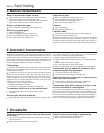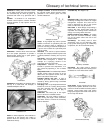
REF•16 Fault finding
7 Driveshafts
Clicking or knocking noise on turns (at slow speed
on full-lock)
ⅥⅥ Lack of constant velocity joint lubricant, possibly due to damaged
bellows (Chapter 8).
ⅥⅥ Worn outer constant velocity joint (Chapter 8).
Vibration when accelerating or decelerating
ⅥⅥ Worn inner constant velocity joint (Chapter 8).
ⅥⅥ Bent or distorted driveshaft (Chapter 8).
6 Automatic transmission
Note: Due to the complexity of the automatic transmission, it is difficult
for the home mechanic to properly diagnose and service this unit. For
problems other than the following, the vehicle should be taken to a
dealer service department or automatic transmission specialist. Do not
be too hasty in removing the transmission if a fault is suspected, as
most of the testing is carried out with the unit still fitted.
Fluid leakage
ⅥⅥ Automatic transmission fluid is usually dark in colour. Fluid leaks
should not be confused with engine oil, which can easily be blown onto
the transmission by airflow.
ⅥⅥ To determine the source of a leak, first remove all built-up dirt and
grime from the transmission housing and surrounding areas using a
degreasing agent, or by steam-cleaning. Drive the vehicle at low
speed, so airflow will not blow the leak far from its source. Raise and
support the vehicle, and determine where the leak is coming from. The
following are common areas of leakage:
a) Fluid pan or “sump” (Chapter 1 and 7B).
b) Dipstick tube (Chapter 1 and 7B).
c) Transmission-to-fluid cooler pipes/unions (Chapter 7B).
Transmission fluid brown, or has burned smell
ⅥⅥ Transmission fluid level low, or fluid in need of renewal
(Chapter 1).
General gear selection problems
ⅥⅥ Chapter 7B deals with checking and adjusting the selector cable
on automatic transmissions. The following are common problems
which may be caused by a poorly-adjusted cable:
a) Engine starting in gears other than Park or Neutral.
b) Indicator panel indicating a gear other than the one actually being
used.
c) Vehicle moves when in Park or Neutral.
d) Poor gear shift quality or erratic gear changes.
ⅥⅥ Refer to Chapter 7B for the selector cable adjustment procedure.
Transmission will not downshift (kickdown) with
accelerator pedal fully depressed
ⅥⅥ Low transmission fluid level (Chapter 1).
ⅥⅥ Incorrect selector cable adjustment (Chapter 7B).
Engine will not start in any gear, or starts in gears
other than Park or Neutral
ⅥⅥ Incorrect starter/inhibitor switch adjustment (Chapter 7B).
ⅥⅥ Incorrect selector cable adjustment (Chapter 7B).
Transmission slips, shifts roughly, is noisy, or has
no drive in forward or reverse gears
ⅥⅥ There are many probable causes for the above problems, but the
home mechanic should be concerned with only one possibility - fluid
level. Before taking the vehicle to a dealer or transmission specialist,
check the fluid level and condition of the fluid as described in Chapter 1.
Correct the fluid level as necessary, or change the fluid and filter if
needed. If the problem persists, professional help will be necessary.
5 Manual transmission
Noisy in neutral with engine running
ⅥⅥ Input shaft bearings worn (noise apparent with clutch pedal
released, but not when depressed) (Chapter 7A).*
ⅥⅥ Clutch release bearing worn (noise apparent with clutch pedal
depressed, possibly less when released) (Chapter 6).
Noisy in one particular gear
ⅥⅥ Worn, damaged or chipped gear teeth (Chapter 7A).*
Difficulty engaging gears
ⅥⅥ Clutch fault (Chapter 6).
ⅥⅥ Worn or damaged gear linkage (Chapter 7A).
ⅥⅥ Incorrectly-adjusted gear linkage (Chapter 7A).
ⅥⅥ Worn synchroniser units (Chapter 7A).*
Jumps out of gear
ⅥⅥ Worn or damaged gear linkage (Chapter 7A).
ⅥⅥ Incorrectly-adjusted gear linkage (Chapter 7A).
ⅥⅥ Worn synchroniser units (Chapter 7A).*
ⅥⅥ Worn selector forks (Chapter 7A).*
Vibration
ⅥⅥ Lack of oil (Chapter 1).
ⅥⅥ Worn bearings (Chapter 7A).*
Lubricant leaks
ⅥⅥ Leaking differential output (driveshaft) oil seal (Chapter 7A).
ⅥⅥ Leaking housing joint (Chapter 7A).*
*Although the corrective action necessary to remedy the symptoms
described is beyond the scope of the home mechanic, the above
information should be helpful in isolating the cause of the condition, so
that the owner can communicate clearly with a professional mechanic.


















